One of the most spectacular animal shows on the African continent is the great migration where more than 1 million wildebeest - and other animals move hundreds of kilometres from Tanzania to Kenya and back in search of water and pasture.
While the great migration has many animals such as zebras, gazelles, lions, hyenas and birds, it is the wildebeests that take centre stage.
In this article, we'll look deeper at these wildebeests and what makes them special. From physical characteristics to social behaviours, dangers, conservation and much more.
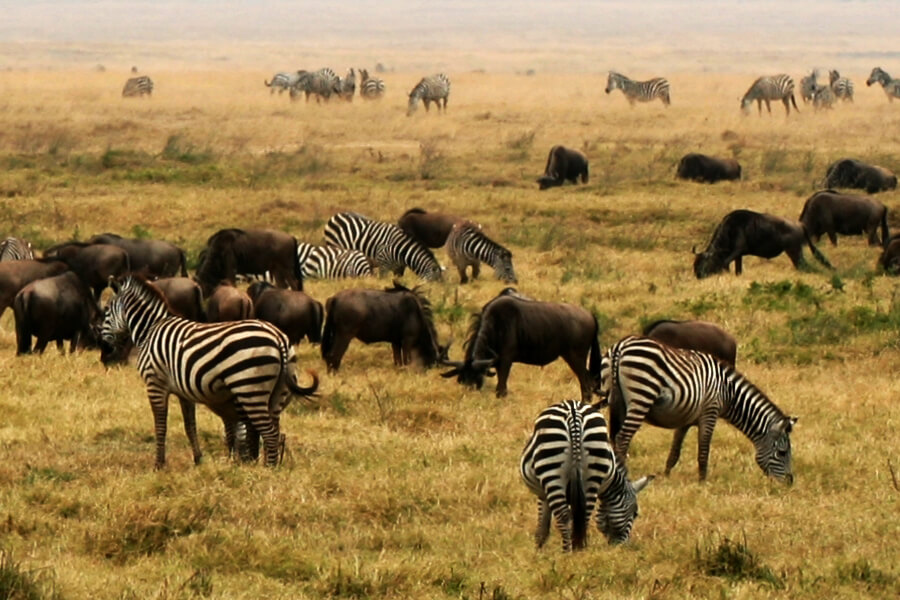
Interesting Facts About Wildebeests
1. Where Do Wildebeest Live
Wildebeests live in the plains and open woodlands of Eastern and Southern Africa. They like areas that are neither too dry nor too wet, with short grass for grazing on.
You can see Wildebeest in the wild areas of the following countries.
|
|
|
|
|
|
|
|
|
|
2. What Do Wildebeests Eat?
Wildebeests are herbivores and prefer to eat grass. Wildebeests only eat vegetation, and when the grass is rare, they eat the leaves and shoots of some plants.
3. How Big Is A Wildebeest?
Wildebeests are big animals and can stand at a shoulder height of 5 feet. The Blue wildebeests are taller and bigger than the black wildebeests. In both species of wildebeest, the males are bigger than the females.
| WILDEBEEST SIZE | MALE | FEMALE |
|---|---|---|
| Blue Wildebeest | 5 feet | 4.4 feet |
| Black Wildebeest | 4 feet | 3.5 feet |
4. How Much Does A Wildebeest Weigh?
Adult wildebeests weigh between 150kg (330 lb) and 250 kg (550 lb). Since the Blue wildebeests are bigger, they weigh heavier than their black counterparts. Generally, the male wildebeests are bigger and thus weigh more than their female counterparts.
| WILDEBEEST WEIGHT | MALE | FEMALE |
|---|---|---|
| Blue Wildebeest | 250 kg | 180 kg |
| Black Wildebeest | 180 kg | 150 kg |
Related article: Heaviest African Wild animals
5. Are Wildebeests Related To Cattle?
Wildebeest is related to domestic cattle because they belong are both even-toed ungulates (large mammals with hooves). Wildebeest is part of the Bovidae family, which includes antelopes, cattle, sheep, and goats among others.
6. Kinds Of Wildebeest
There are 2 species of wildebeest in Africa, the blue wildebeest and the black wildebeest.
The Blue Wildebeest is also called the brindled gnu while the black wildebeest can also be called the white-tailed gnu.
7. Blue Wildebeest Vs Black Wildebeest
You can easily distinguish between the 2 species of wildebeest by their colours and features such as manes, horns and tails.
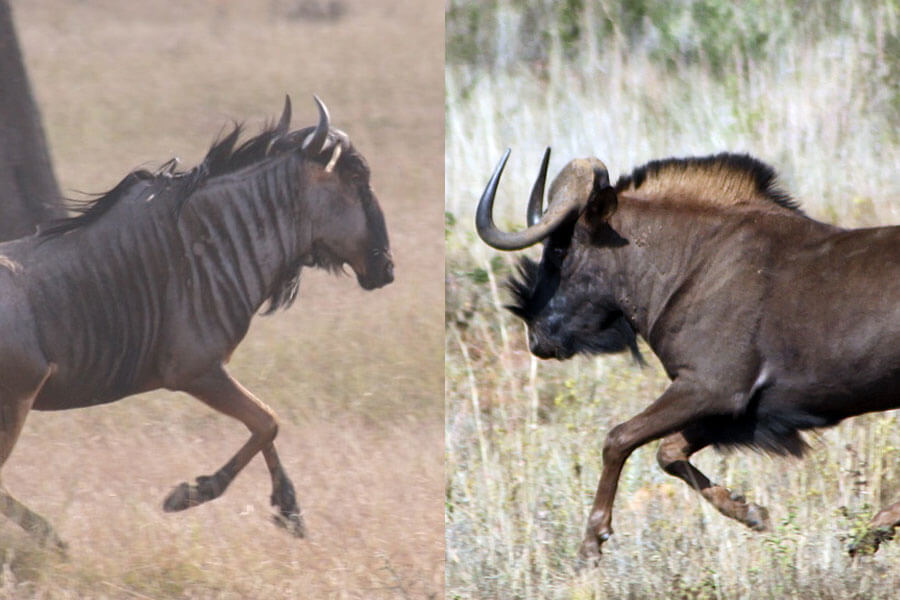
The black wildebeest has brown-coloured hair, a mane that ranges from cream to black as well as a cream-coloured tail. The Blue wildebeest has a dark grey colour with stripes and can have a bluish sheen at certain angles.
The horns of the blue wildebeest protrude down and to the sides, while those of a black wildebeest protrude down and then to the front.
8. Are There Blue And Black Wildebeest Hybrids?
Yes, blue and black wildebeest species are known to hybridize with each other. In a shared habitat, blue and black wildebeest have been noted to reproduce and have fertile offspring.
The hybrid offspring are said to be slightly bigger but also possess disadvantages concerning the strength of their teeth and bones.
While these hybrid wildebeests occur, they are mostly restricted by social behaviour and differences in habitat.
9. Are Wildebeest Aggressive?
Wildebeests are generally peaceful animals that can easily intermix with other animals and are not known for unpredictable tempers. Being a big animal with sharp horns, a wildebeest can inflict serious harm to its predators such as lions and leopards, so it is not completely harmless.
There are very rare cases of Wildebeest attacking humans but an enraged wildebeest can be dangerous, especially due to its big size and sharp horns.
For your safety don't try to touch a wildebeest and follow the guidelines of your safari guide.
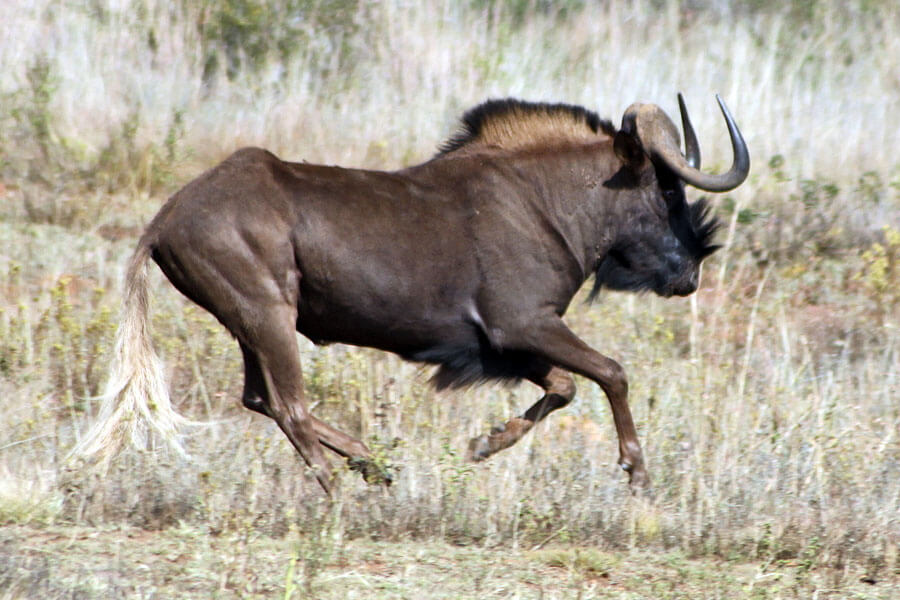
10. How Fast Do Wildebeests Run?
Wildebeest can run really fast at speeds of 80 kilometres per hour (50 mph). While this is the same speed as a lion, the wildebeest has better endurance and can outrun a lion unless the lion pounces from a very short distance and quickly catches the wildebeest.
11. How Many Wildebeests Live In A Herd?
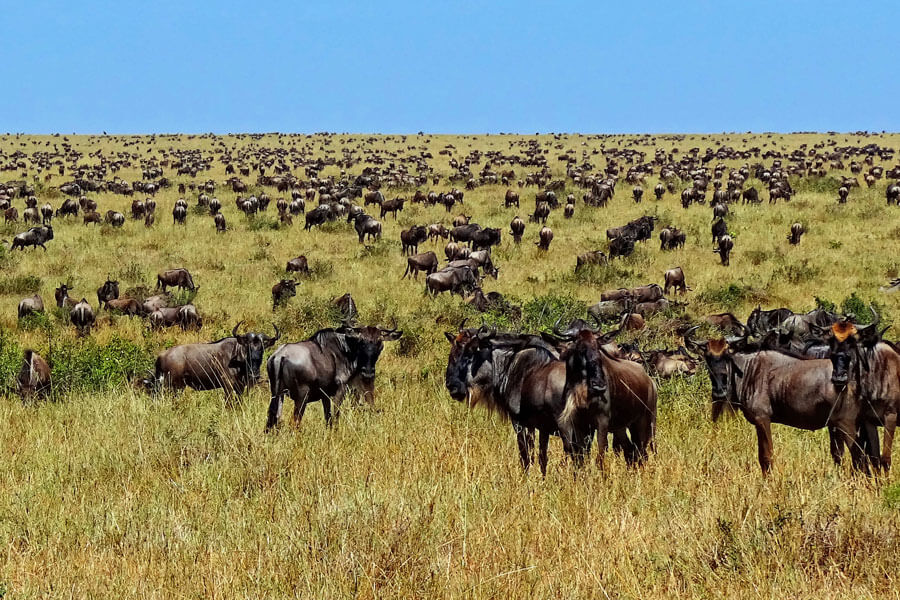
Wildebeests live in herds of different sizes, ranging from 50 to the super herds of the migration which are comprised of many primary herds. They can split into smaller groups to make sure that there is enough food for all but band together in the face of danger to form a bigger more intimidating group.
12. Why Do Wildebeest Migrate
Wildebeests migrate to look for grazing land and surface water.
As the animals follow the rains, it is thought that another important factor is the levels of phosphorous and nitrogen in the grasses. Phosphorous is of crucial importance for wildebeest, particularly lactating mothers.
13. How Long Do Wildebeest Migrate
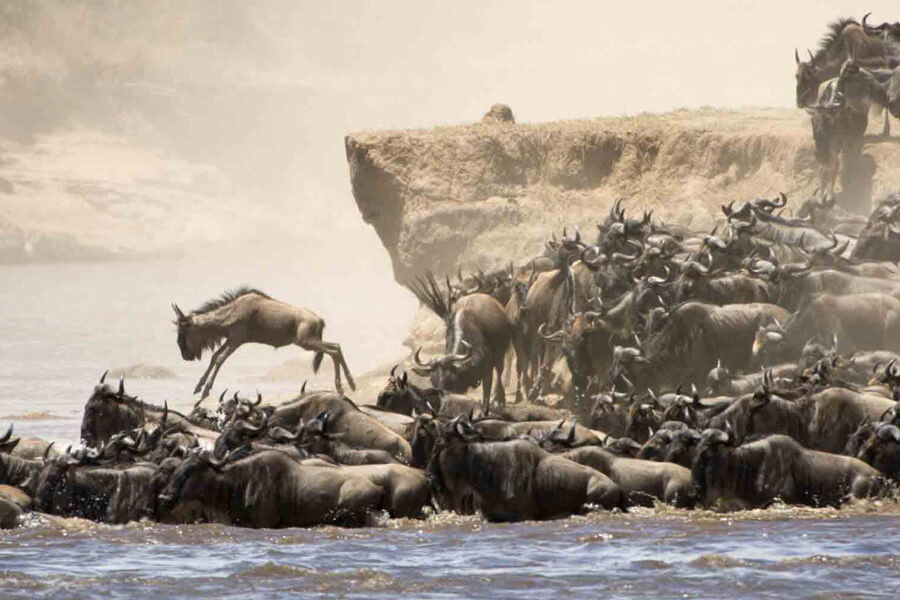
Wildebeests migrate for very long distances. Wildebeests in the Great Migration move from Serengeti National Park in Tanzania to Masai Mara National Reserve in Kenya and cover more than 1600 kilometres each year.
This is the longest distance covered by migrating wildebeest.
14. How Do Wildebeests/Gnus Reproduce
Male wildebeests establish temporary territories in the mating season and defend the territories from intruding males.
The pregnancy lasts about 8.5 months and birth is often to one calf. The newborn wildebeest calf weighs about 21 kg (46 lb) can get on its feet within minutes, and can move with the herd shortly after.
15. How Wildebeests Communicate
Wildebeests communicate in many ways with each other and other animals. This is why they can quickly form big herds in the face of danger.
Impressively Wildebeests can listen and distinguish the call of other animals, and therefore know when there is a likeliness of danger.
16. Do Wildebeests Sleep?
Wildebeests have developed a unique sleeping behaviour that helps to keep them safe while they rest. When wildebeests sleep, a portion of the herd remains alert and ready to warn the others of any impending danger. This allows the rest of the herd to sleep for at least 4 hours each day, knowing that they will be alerted if they need to flee from a predator.
This behaviour is known as "watchful resting," and it's not just wildebeests that exhibit it. Many other social animals, such as zebras, antelopes, and elephants, also engage in watchful resting to keep themselves safe while they sleep.
By staying alert and ready to respond to potential threats, these animals can get the rest they need to stay healthy and strong.
17. What Eats Wildebeest?
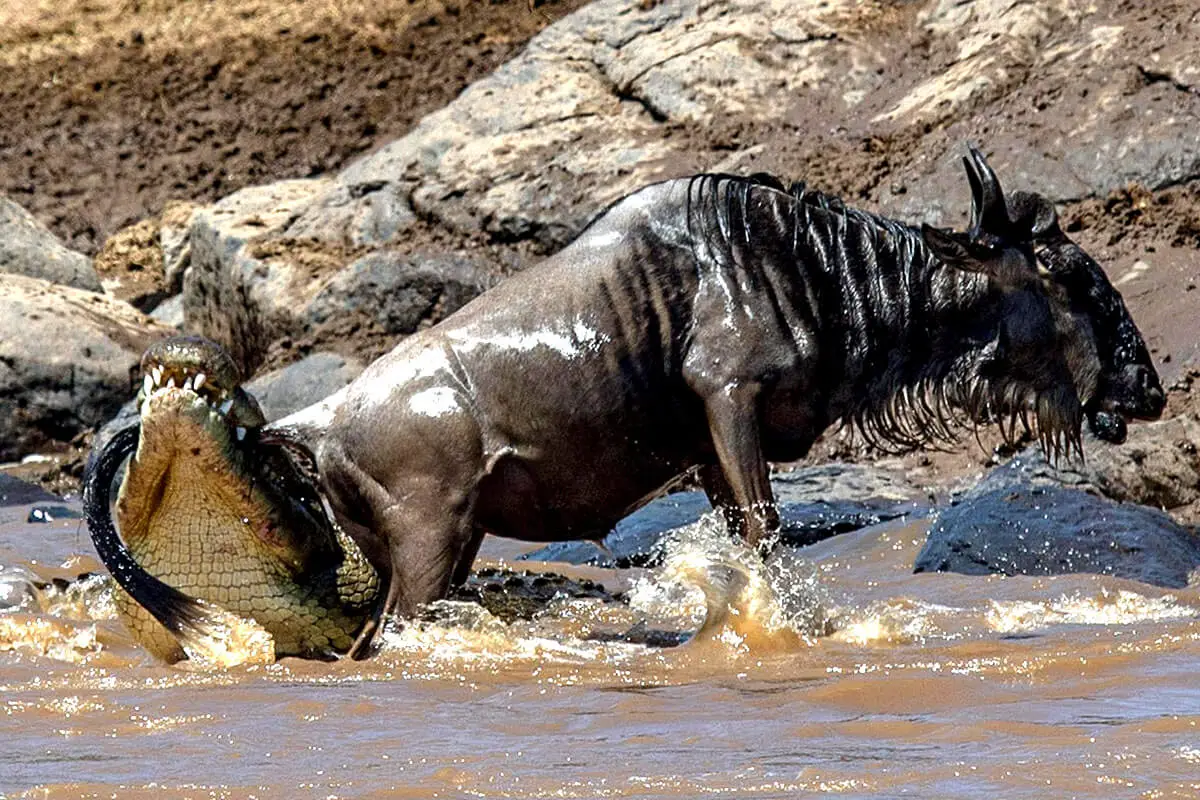
Wildebeests can be killed for food by many of the major predators in the wild. Wildebeests are killed by lions, hyenas, African wild dogs, cheetahs, leopards and crocodiles.
The main target for predators is the young wildebeest which are still small, as well as the sick or injured individuals that are unable to defend themselves.
Able-bodied adults are hard to kill and would require a collaboration of many animals, yet still end up with some injuries to the lions, cheetahs, leopards or hyenas.
18. How Do Wildebeests Resist Predators?
The wildebeests protect themselves from predators by forming herds and protecting their weak and young members in the centre. During migration, the larger 'mega herd' is an even better defence system against approaching danger.
Sometimes, the large herds are mixed in with other animals such as zebras, gazelles and more.
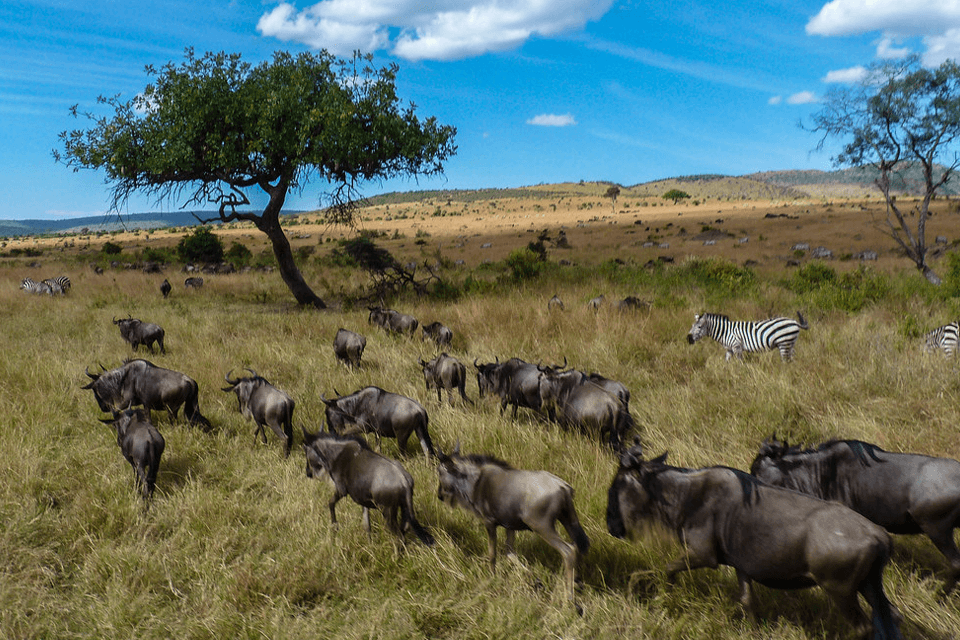
19. How Long Do Wildebeest Live
The average lifespan of a wildebeest is 20 years, but some individuals can live for longer and reach up to 40 years.
In either case, the wildebeest's lifespan is much longer than that of other animals in the savannah, especially the predators such as lions, cheetahs, leopards and hyenas.
Conservation
According to the International Union for the Conservation of Nature (IUCN), wildebeests are not in any danger and are classified as LEAST CONCERN.
There are more than 2 million wildebeests in the wild and their populations are stable.
Final Thoughts
Like many animals, the wildebeest is very interesting to learn about, and even more interesting to see in the wilderness.
The best way to see wildebeests is undoubtedly during the great migration from Serengeti in Tanzania to Masai Mara in Kenya. If you plan on visiting Tanzania, the schedule for you to enjoy the migration is more flexible but the crossing of the Mara River is the epic show that brings out the hungry crocodile ready to pounce.
We hope you enjoyed learning more about the wildebeest and that this knowledge can make your face-to-face experience on a safari even better.
